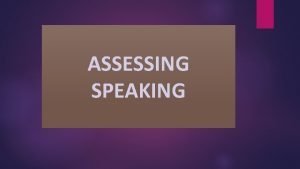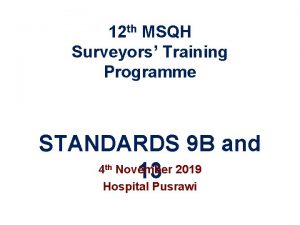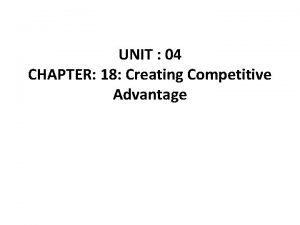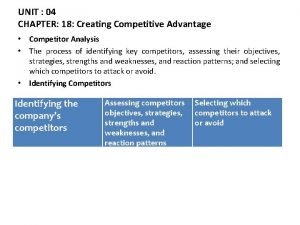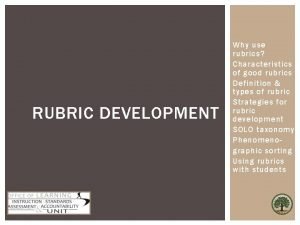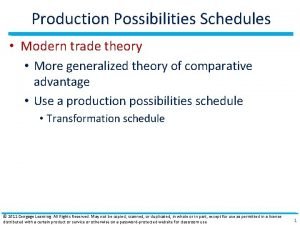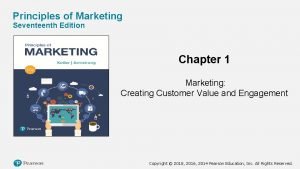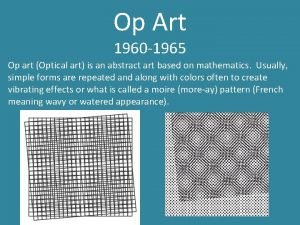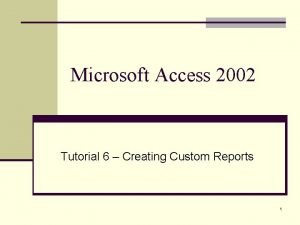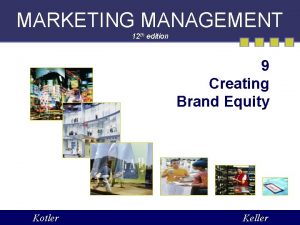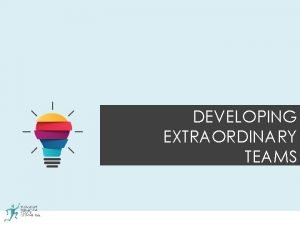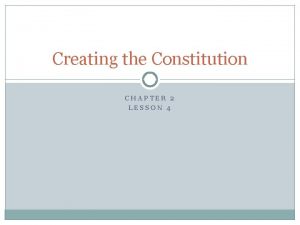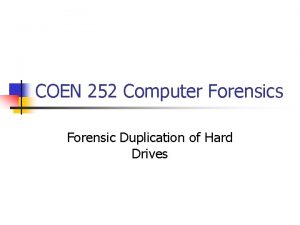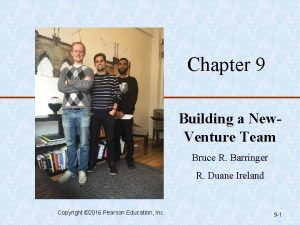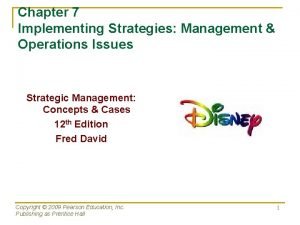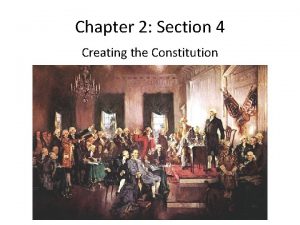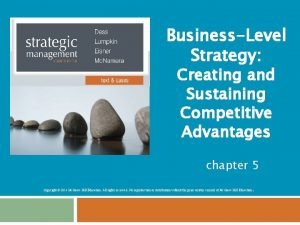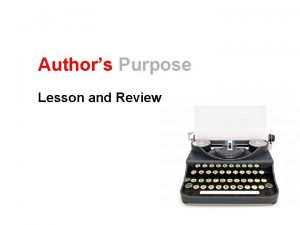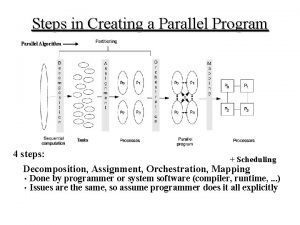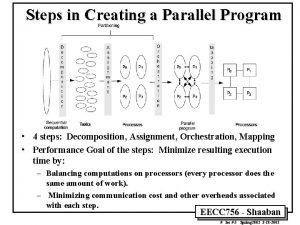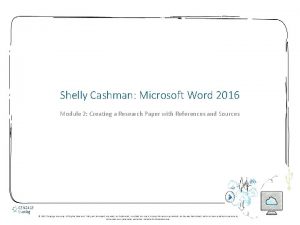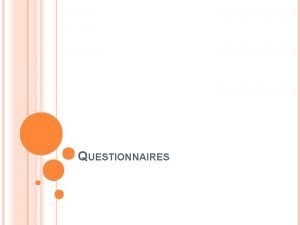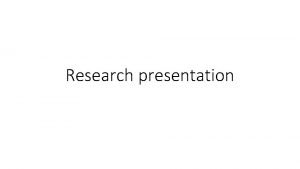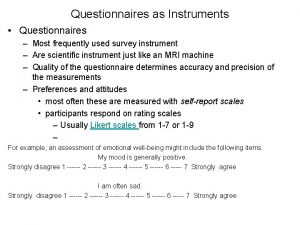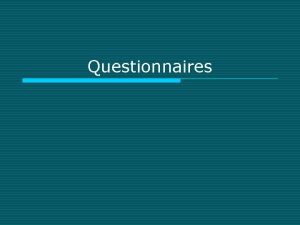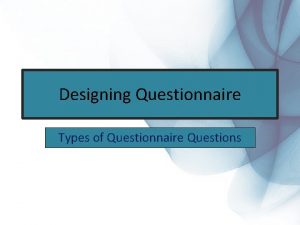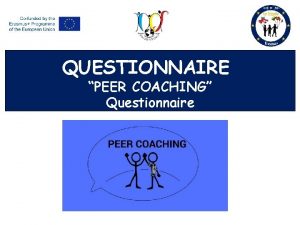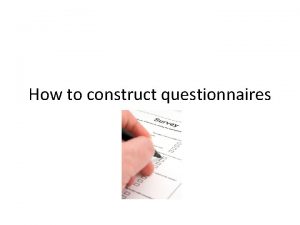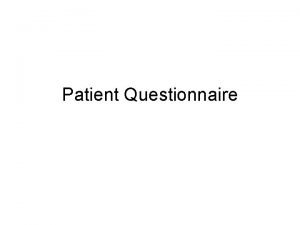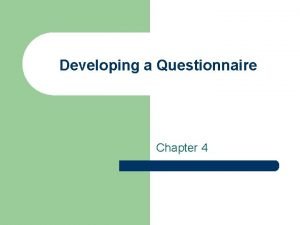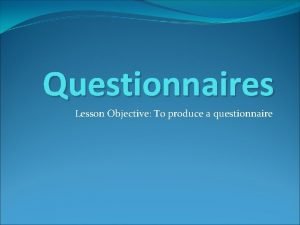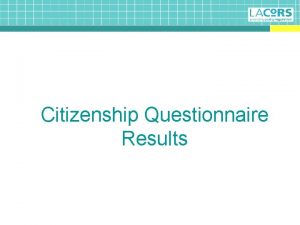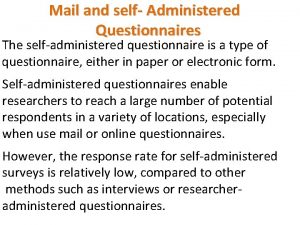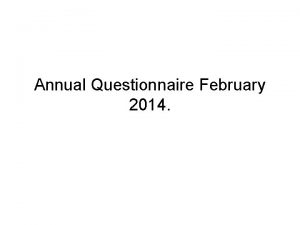Creating a Questionnaire Questionnaire Development Questionnaire Development Questionnaires




































- Slides: 36

Creating a Questionnaire

Questionnaire Development

Questionnaire Development Questionnaires are created in a nine step process…. . Each step is important… and cannot be skipped.

Questionnaire Development 1. What information is needed? a. Review purpose of study

Questionnaire Development 1. What information is needed? a. Review purpose of study b. Create a dummy table.

Questionnaire Development 1. What information is needed? 2. How will the questionnaire be used? 3. Content of questions Write down every question you can think of. Create a list. Then…. . a. Is this question necessary? b. Will respondents answer this question? c. Can respondents answer this question?

Questionnaire Development 1. What information is needed? 2. How will the questionnaire be used? 3. Content of questions Remember: All questions are intrusions on an individual’s time and goodwill!

Always respect your respondents….

Questionnaire Development 1. 2. 3. 4. What information is needed? How will the questionnaire be used? Content of questions How will people respond to questions?

Questionnaire Development 4. How will people respond to questions? Think of the exams you have taken. Surveys are a type of exam…. . What did you like and what did you dislike?

Questionnaire Development 4. How will people respond to questions? Think of the exams you have taken. Surveys are a type of exam…. . Multiple-choice questions: 2. Which decision rule is a "bottom-up" approach? a) rational appeals b) lexicographic c) conjunctive d) compensatory rules

Questionnaire Development 4. How will people respond to questions? Think of the exams you have taken. Surveys are a type of exam…. . Opened-ended questions: 2. The ________ decision rule is a "bottom-up" approach to decision making.

Questionnaire Development 4. How will people respond to questions? Think of the exams you have taken. Surveys are a type of exam…. . Essay questions: 2. What is the difference between a lexicographic rule and a conjunctive rule in customer decision making?

Questionnaire Development 4. How will people respond to questions? Closed-ended questions: (Aided-recall) Respondent selects an answer already given….

Questionnaire Development 4. How will people respond to questions? Closed-ended questions: ADVANATAGES: • High structure • Less field (less variance) • Recall memory

Questionnaire Development 4. How will people respond to questions? Closed-ended questions: DISADVANATAGES: • Selection bias (Why would your answers be the best? ) • Ballot bias


Questionnaire Development 4. How will people respond to questions? Closed-ended questions: DISADVANATAGES: • Selection bias (Why would your answers be the best? ) • Ballot bias • Position bias

Questionnaire Development 4. How will people respond to questions? Closed-ended questions: Creation: • Mutually exclusive (More than one answer can’t be correct. ) 2. Collectively exhaustive (All possible answers must be given… if there is a selection of possible options. )

Questionnaire Development 4. How will people respond to questions? Open-ended questions: (Unaided-recall) The respondent has to create the answer.

Questionnaire Development 4. How will people respond to questions? Open-ended questions: (Unaided-recall) ADVANATAGES: • Good for insightful data • Good for probes • Create less response bias

Questionnaire Development 4. How will people respond to questions? Open-ended questions: (Unaided-recall) DISADVANATAGES: • Verbosity bias • Space/Time bias • Low structure

Structure: Study on Personal Space

Questionnaire Development 1. 2. 3. 4. 5. What information is needed? How will the questionnaire be used? Content of questions How will people respond to questions? How will each question be worded? a. Can respondents understand the question? Use simple words (at the 5 th to 6 th grade level)

Questionnaire Development 1. 2. 3. 4. 5. What information is needed? How will the questionnaire be used? Content of questions How will people respond to questions? How will each question be worded? a. Can respondents understand the question? Avoid words that are: ambiguous full of jargon

Questionnaire Development 1. 2. 3. 4. 5. What information is needed? How will the questionnaire be used? Content of questions How will people respond to questions? How will each question be worded? a. Can respondents understand the question? b. Questions should be: Brief (Brevity) Objective (to the point)

Questionnaire Development 1. 2. 3. 4. 5. 6. What information is needed? How will the questionnaire be used? Content of questions How will people respond to questions? How will each question be worded? Where will questions be positioned?

Questionnaire Development 6. Where will questions be positioned? a. Format: Introduction Substantive Classification


Questionnaire Development 6. Where will questions be positioned? a. Format b. Simplicity and straightforward presentation c. Facilitate analysis and interpretation

Questionnaire Development 6. Where will questions be positioned? a. Format b. Simplicity and straightforward presentation c. Facilitate analysis and interpretation d. Avoid sequence bias e. Use easy questions before hard ones

Questionnaire Development 6. Where will questions be positioned? a. Format b. Simplicity and straightforward presentation c. Facilitate analysis and interpretation d. Avoid sequence bias e. Use easy questions before hard ones f. Be careful with funnel and branching questions


Questionnaire Development 1. 2. 3. 4. 5. 6. 7. What information is needed? How will the questionnaire be used? Content of questions How will people respond to questions? How will each question be worded? Where will questions be positioned? Format of questionnaire Good questionnaires look: a. good b. easy to work with

Questionnaire Development 1. 2. 3. 4. 5. 6. 7. 8. What information is needed? How will the questionnaire be used? Content of questions How will people respond to questions? How will each question be worded? Where will questions be positioned? Format of questionnaire Review www. journal. au. edu/abac_journal/dec 98/article_shaukat. html

Questionnaire Development 1. 2. 3. 4. 5. 6. 7. 8. 9. What information is needed? How will the questionnaire be used? Content of questions How will people respond to questions? How will each question be worded? Where will questions be positioned? Format of questionnaire Review Pre-test Always!!!
 Angket terstruktur dan tidak terstruktur
Angket terstruktur dan tidak terstruktur Picture cued task in speaking
Picture cued task in speaking Pisa 2015 questionnaire
Pisa 2015 questionnaire Lecture automatique de questionnaires
Lecture automatique de questionnaires Msqh survey questionnaires
Msqh survey questionnaires Interviews and questionnaires
Interviews and questionnaires Questionnaires about vaal river
Questionnaires about vaal river Blake elohim creating adam
Blake elohim creating adam Chapter 18 creating competitive advantage
Chapter 18 creating competitive advantage Competitor centered company
Competitor centered company Creating a dinosaur sculpture
Creating a dinosaur sculpture Good rubrics
Good rubrics Creating production possibilities schedules and curves
Creating production possibilities schedules and curves Chapter 1 marketing
Chapter 1 marketing You are creating in prtu the value fund portfolio
You are creating in prtu the value fund portfolio Op art 1960
Op art 1960 How to build a cloud center of excellence gartner
How to build a cloud center of excellence gartner Access reports tutorial
Access reports tutorial Creating brand equity kotler
Creating brand equity kotler Creating a cladogram worksheet answer key
Creating a cladogram worksheet answer key Creating extraordinary teams
Creating extraordinary teams Chapter 2 lesson 4 creating the constitution
Chapter 2 lesson 4 creating the constitution Creating products for consumers in global markets
Creating products for consumers in global markets Creating an english environment
Creating an english environment How to create forensic duplicate of a hard drive
How to create forensic duplicate of a hard drive Creating a new venture team
Creating a new venture team Creating a strategy supportive culture
Creating a strategy supportive culture Section 4 creating the constitution
Section 4 creating the constitution Creating and sustaining competitive advantage
Creating and sustaining competitive advantage Author's purpose entertain examples
Author's purpose entertain examples Creating customer value satisfaction and loyalty
Creating customer value satisfaction and loyalty Creating customer value satisfaction and loyalty
Creating customer value satisfaction and loyalty Customer perceived value
Customer perceived value What is the correct steps in creating a parallel program
What is the correct steps in creating a parallel program What is the correct steps in creating a parallel program
What is the correct steps in creating a parallel program Word module 2 creating a research paper
Word module 2 creating a research paper Creating supportive environments smoking
Creating supportive environments smoking

